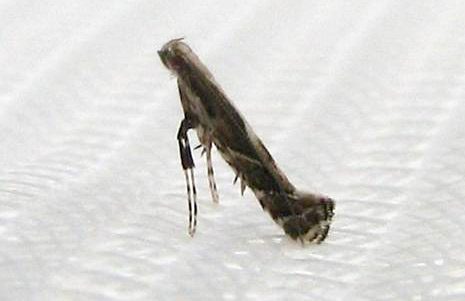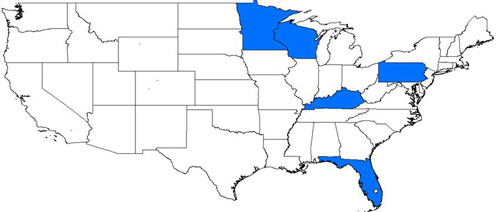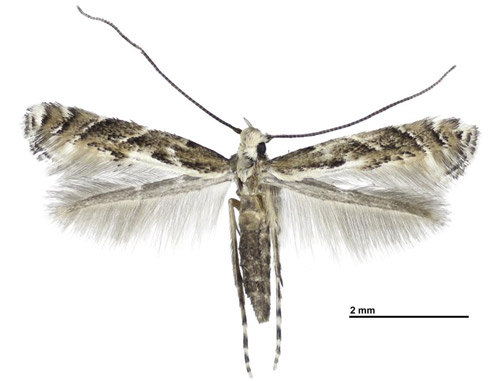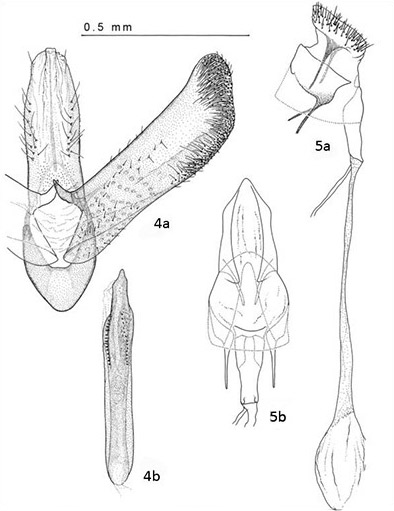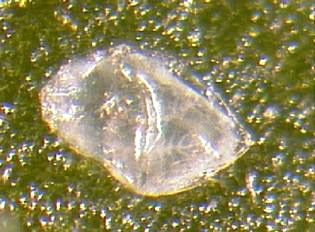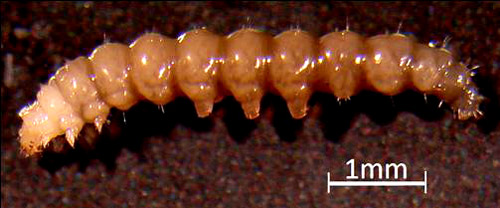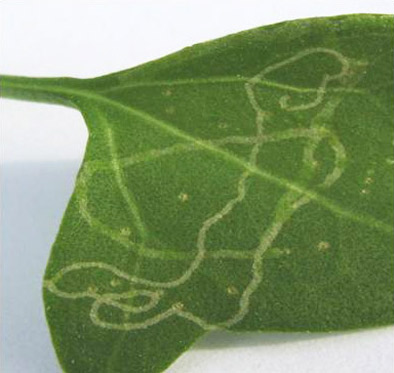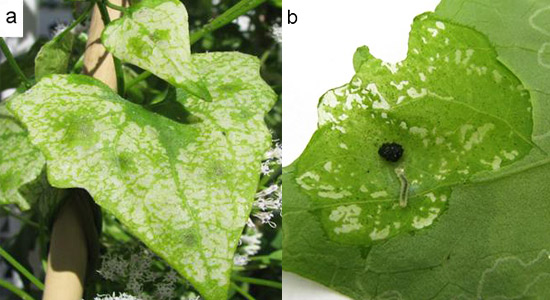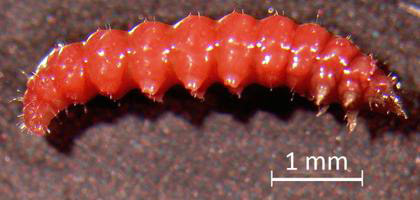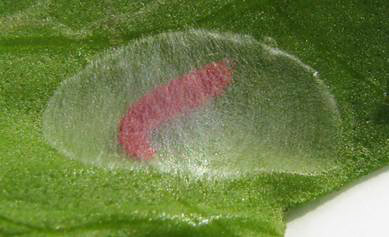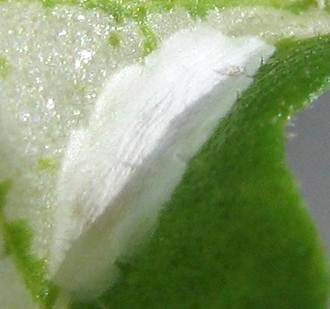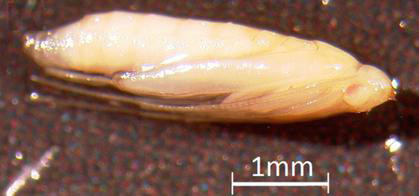common name: aster leafminer moth
scientific name: Leucospilapteryx venustella (Clemens) (Insecta: Lepidoptera: Gracillariidae)
Introduction - Distribution - Description - Biology and Host Plants - Selected References
Introduction (Back to Top)
Leucospilapteryx venustella (Clemens) (Lepidoptera: Gracillariidae) is a small, mostly light brown moth that during its larval stages creates mines in the leaves of plants in the family Asteraceae. Feeding damage by the early instars is characterized by serpentine mines that are expanded by later instars to form tentiform or blotch mines.
Figure 1. Adult resting posture of Leucospilapteryx venustella (Clemens). Photograph by Rodrigo Diaz, University of Florida.
Distribution (Back to Top)
Leucospilapteryx venustella occurs in North America including Canada (Québec) and the United States. In the US, it is found in Wisconsin, Minnesota, Pennsylvania, Kentucky (Opler et al. 2013), Illinois (Harrison and Berenbaum 2012), and Florida (R. Diaz unpublished data) (Fig. 1). The disjunct distribution could be due to inadequate sampling.
Figure 2. States where Leucospilapteryx venustella (Clemens) has been reported in the United States. Map by Rodrigo Diaz, University of Florida.
Description (Back to Top)
Adults: Adults are light brown with a forewing length of approximately 4.2 ± 0.2 mm ( ± indicates the standard deviation in this measurement). The moth’s head is covered by relatively broad, flat, white scales above the eyes and between the antennae. The forewings are patterned in various shades of brown, with 3 to 4 slender, oblique bands (strigulae) of white from the anterior (costal) margin of the wing. The hind margin of the basal half of the forewing is also white (Fig. 2). Adults rest in a 45 degree angle posture (Fig. 3). Figure 4 and 5 illustrate the genitalia of the male and female, respectively.
Figure 3. Adult of Leucospilapteryx venustella (Clemens). Photograph by Karolyn Darrow, Smithsonian Institution, Washington, D.C.
Figures 4-5. Genitalia of Leucospilapteryx venustella (Clemens). Male: 4a) Ventral view of genital capsule; 4b) Aedeagus. Female: 5a) Lateral view; 5b) Ventral view. Drawings by Vichai Malikul, Smithsonian Institution, Washington, D.C.
Eggs: Leucospilapteryx venustella females oviposit a single egg on the underside of leaves. The white, translucent eggs are minuscule with an approximate length of 0.34 ± 0.1 mm (Fig. 6). The chorion of a hatched egg is found at the initiation of the serpentine mine.
Figure 6. Egg of Leucospilapteryx venustella (Clemens). Photograph by Esteban Tapia, University of Florida.
Larvae: The larvae of Leucospilapteryx venustella are hypermetamorphic (Davis 1987), which means that there are two distinct larval body forms, as is characteristic of members of the family Gracillariidae. Early instars are sap-feeders with flattened bodies and their mouthparts directed forward (prognathous) (Fig. 7). Later instars are leaf-feeders with cylindrical bodies and their mouthparts directed downward (Fig. 8). The body length varies from about 2.7 ± 0.2 mm for early instars to about 4.8 ± 0.3 mm for later instars. The feeding damage by early instars can be recognized as a serpentine mine in the leaf (Fig. 9), while later instars form tentiform or blotch mines, which sometimes contain accumulation of frass (Fig. 10). Before exiting a mine, the larva changes color from whitish to deep red (Fig. 11). The last instar stops feeding, exits the mine, and pupates inside a small cocoon in leaf folds. The prepupal instar searches for crevices on the plant or folds over the leaf edge with silk and forms a cocoon (Fig. 12). The length of the prepupa is 4.0 ± 0.3 mm.
Figure 7. Dorsal view of an early instar Leucospilapteryx venustella (Clemens) larva. Note the forwardly directed mouthparts. Photograph by Esteban Tapia, University of Florida.
Figure 8. Dorsal view of a late instar Leucospilapteryx venustella (Clemens) larva. Note the downwardly directed mouthparts. Photograph by Esteban Tapia, University of Florida.
Figure 9. Serpentine mines caused by early sap-feeding instars of Leucospilapteryx venustella (Clemens). Photograph by Rodrigo Diaz, University of Florida.
Figure 10. a) Mikania scandens leaf with tentiform or blotch mines caused by Leucospilapteryx venustella (Clemens) larvae. b) Open mine with larva and plant tissue damage; note the central accumulation of frass made by the larva. Photographs by Rodrigo Diaz, University of Florida.
Figure 11. Lateral view of the prepupal instar stage of Leucospilapteryx venustella (Clemens). Photograph by Esteban Tapia, University of Florida.
Figure 12. Prepupal instar stage of Leucospilapteryx venustella (Clemens) forming a cocoon. Photograph by Rodrigo Diaz, University of Florida.
Pupa: The pupa is found inside a white cocoon spun by the last instar (Fig. 13). It is light brown and has an approximate length of 3.2 ± 0.2 mm (Fig. 14). Duration of the pupal stage is about 5 to 7 days.
Figure 13. White cocoon of Leucospilapteryx venustella (Clemens). Photograph by Rodrigo Diaz, University of Florida.
Figure 14. Lateral view of the pupa of Leucospilapteryx venustella (Clemens). Photograph by Rodrigo Diaz, University of Florida.
Biology and Host Plants (Back to Top)
Little is known about the biology of Leucospilapteryx venustella. Adults have been associated with plant species in the family Asteraceae. In Illinois, adults have been collected in prairies from June to September using ultraviolet light (Harrison and Berenbaum 2013). Larvae have been reared from the climbing hemp vine, Mikania scandens (L.) Willd (R. Diaz unpublished data), white snakeroot, Ageratina altissima (L.) King & H. Rob., and cutleaf coneflower, Rudbeckia laciniata L. (Anonymous 2014). Despite its close phylogenetic and geographical proximity to Mikania scandens, the exotic vine Mikania micrantha Kunth was not a host of Leucospilapteryx venustella in southern Florida (R. Diaz unpublished data).
Selected References (Back to Top)
- Davis DR. 1987. Gracillariidae, p.372-374, 376-378. In F.W. Stehr (editor), Immature insects, Vol. 1, Kendall/Hunt Publ. Co., Dubuque, Iowa
- Harrison T, Berenbaum MR. 2013. Moth diversity in three biofuel crops and native prairie in Illinois. Insect Science. 20: 407-41
- Anonymous. 2014. Illustrated guide to microlepidoptera. http://www.microleps.org (31 January 2014)
- Opler PA, Kelly L, Naberhaus T. 2013. Butterflies and Moths of North America. http://www.butterfliesandmoths.org (31 January 2014)
